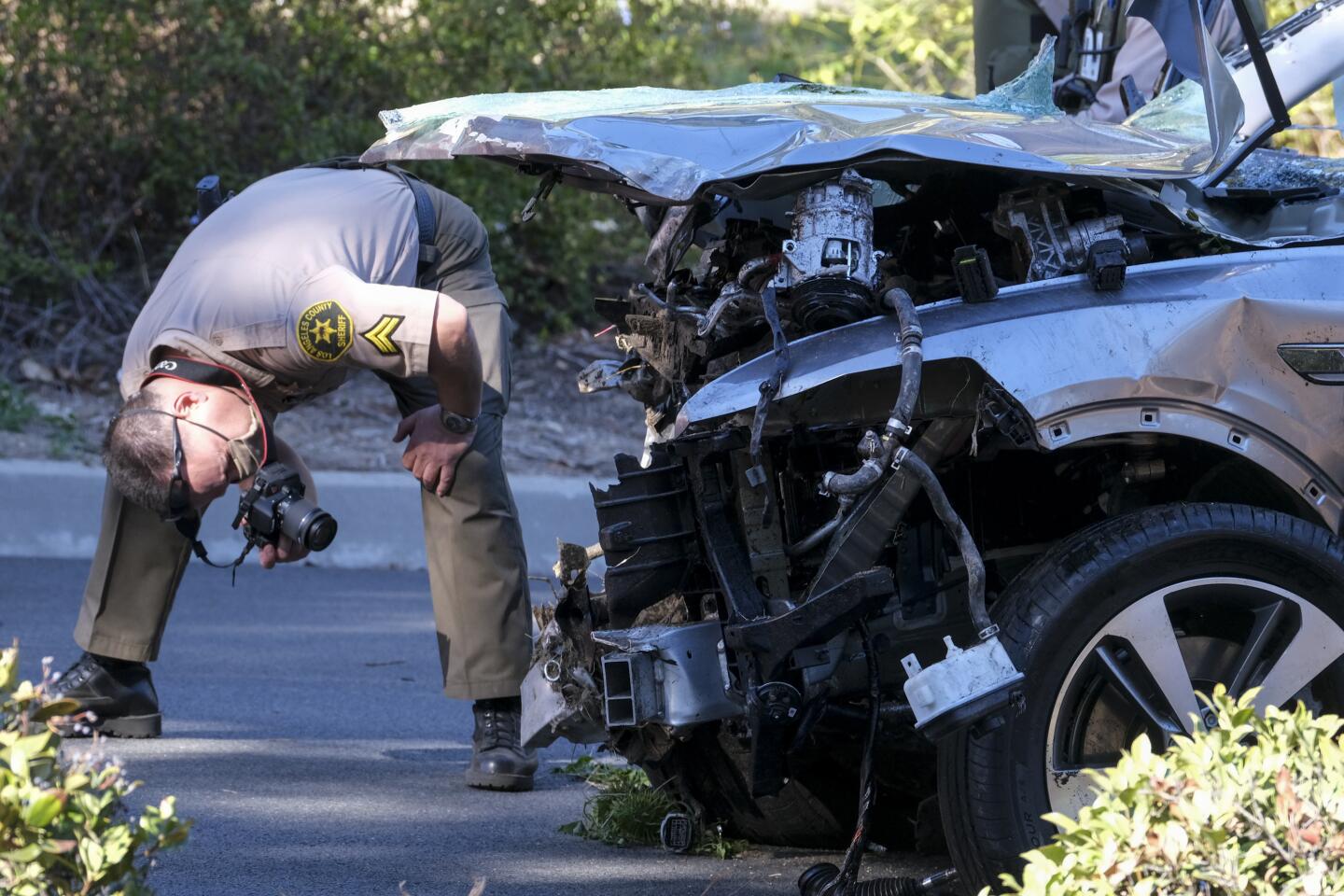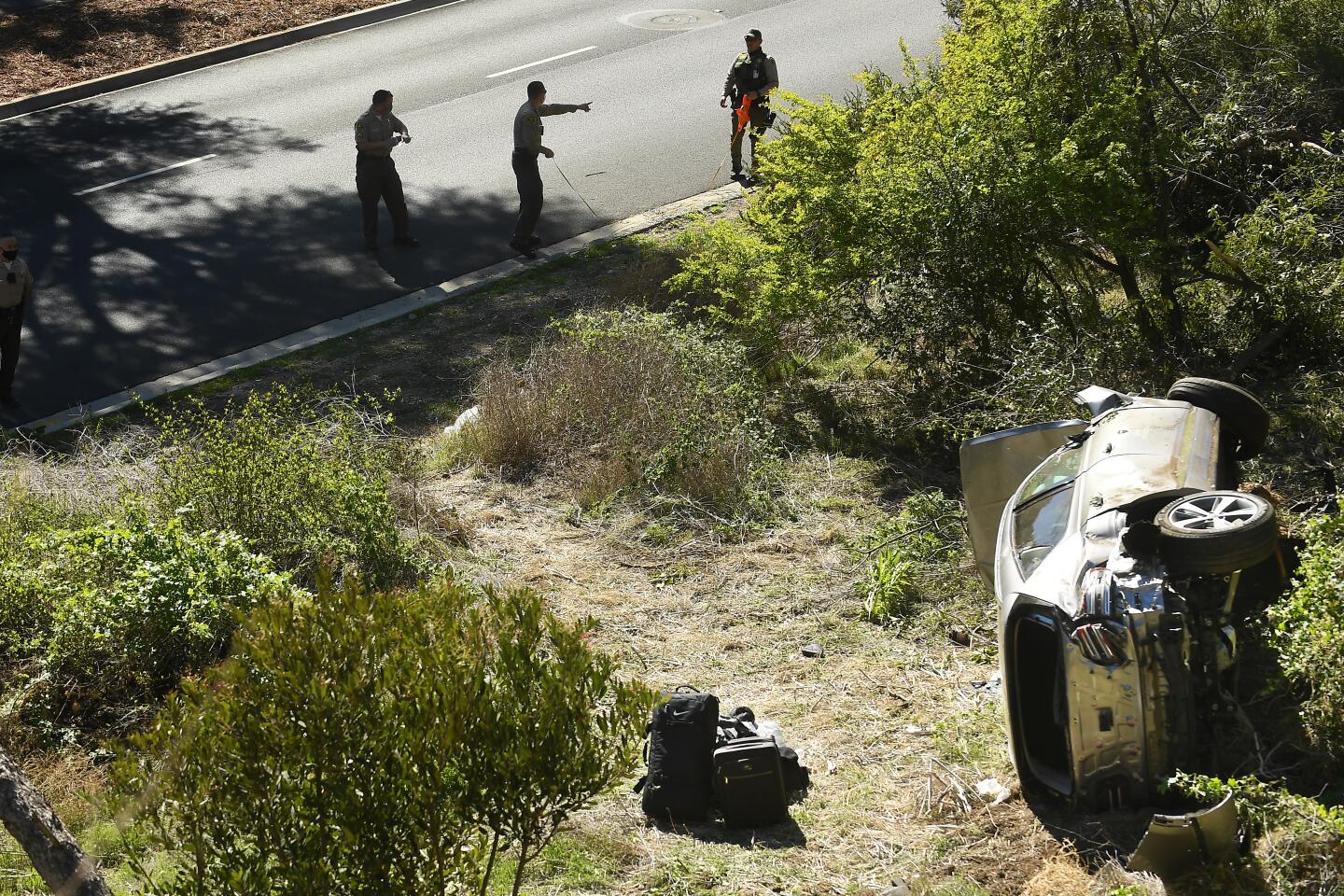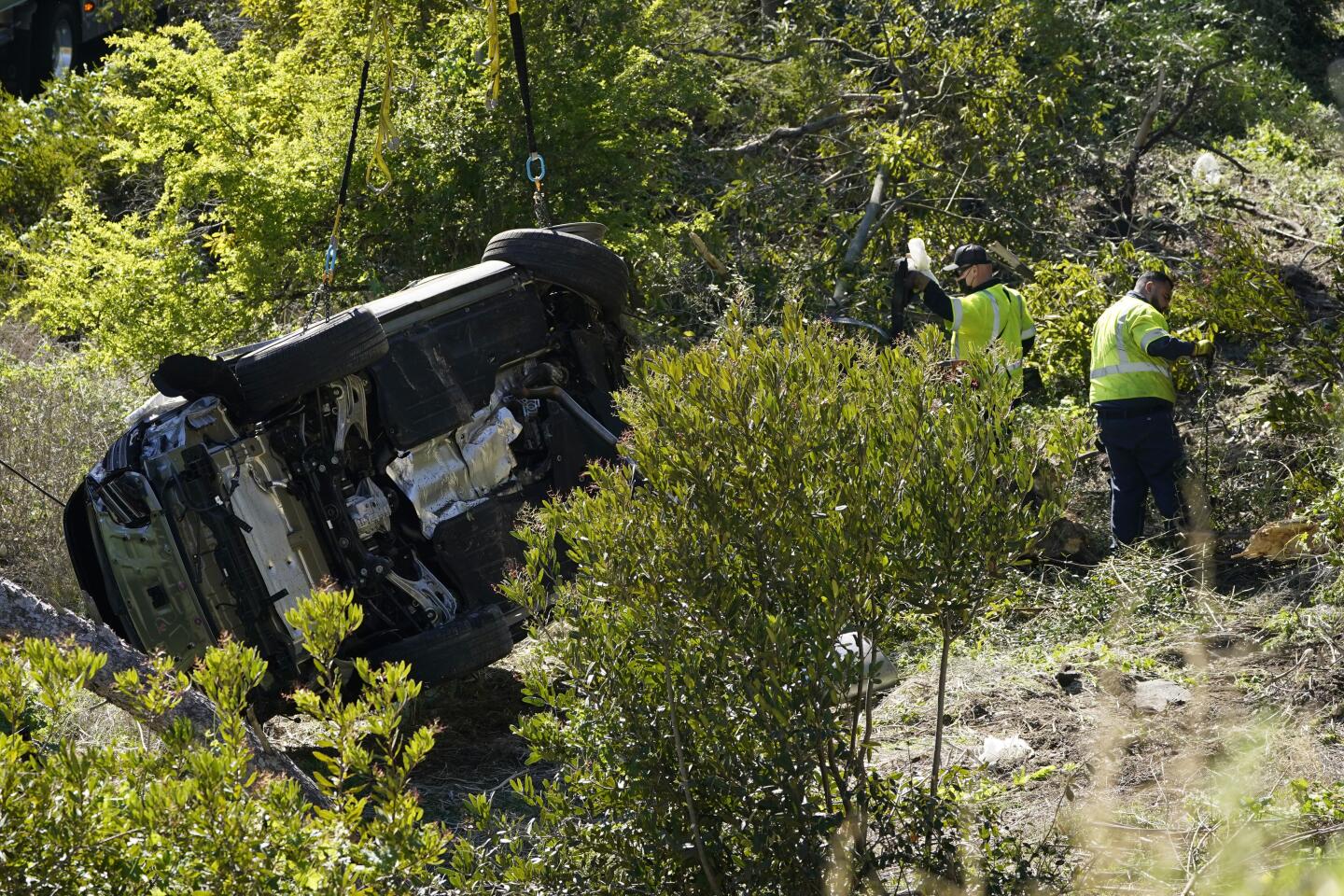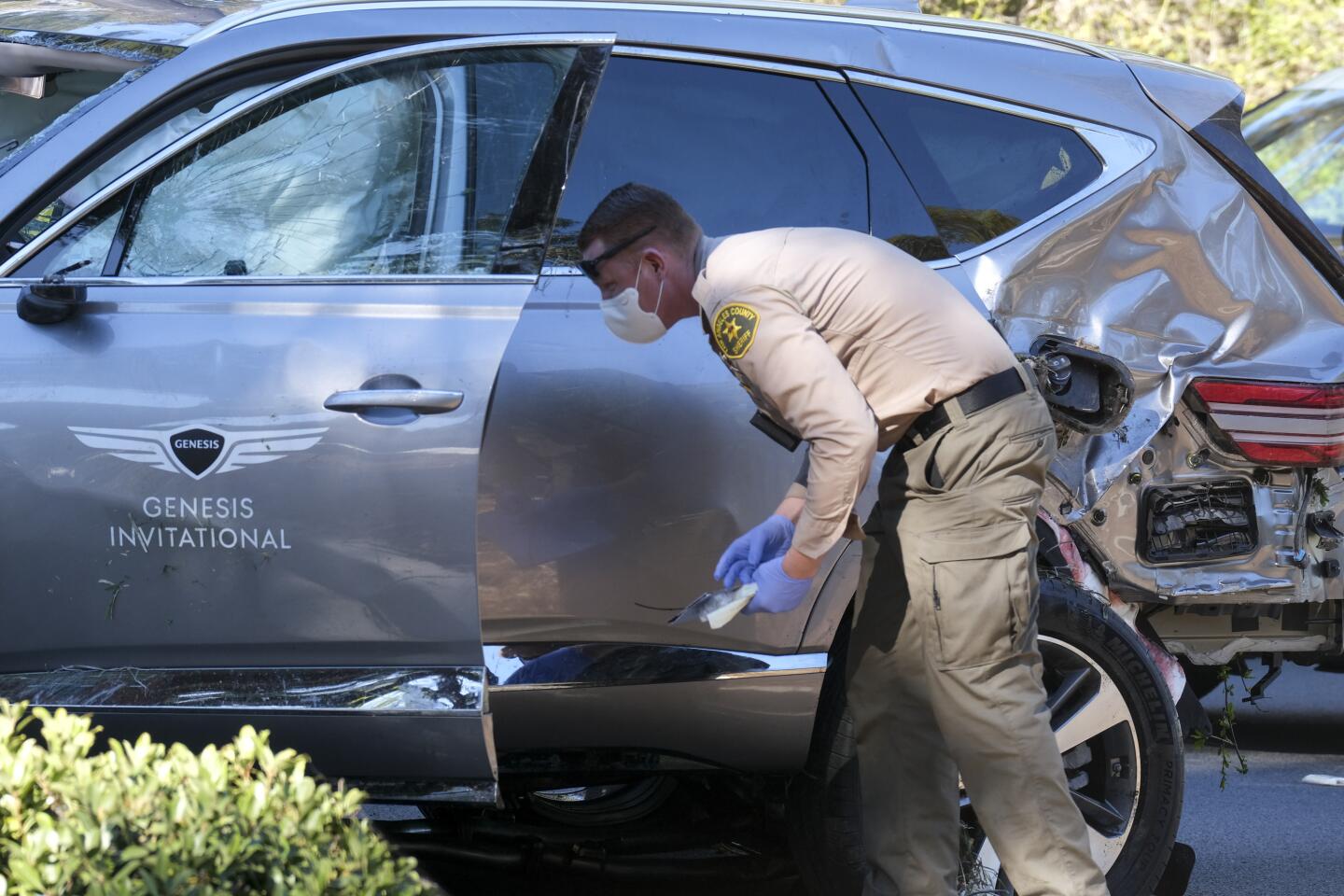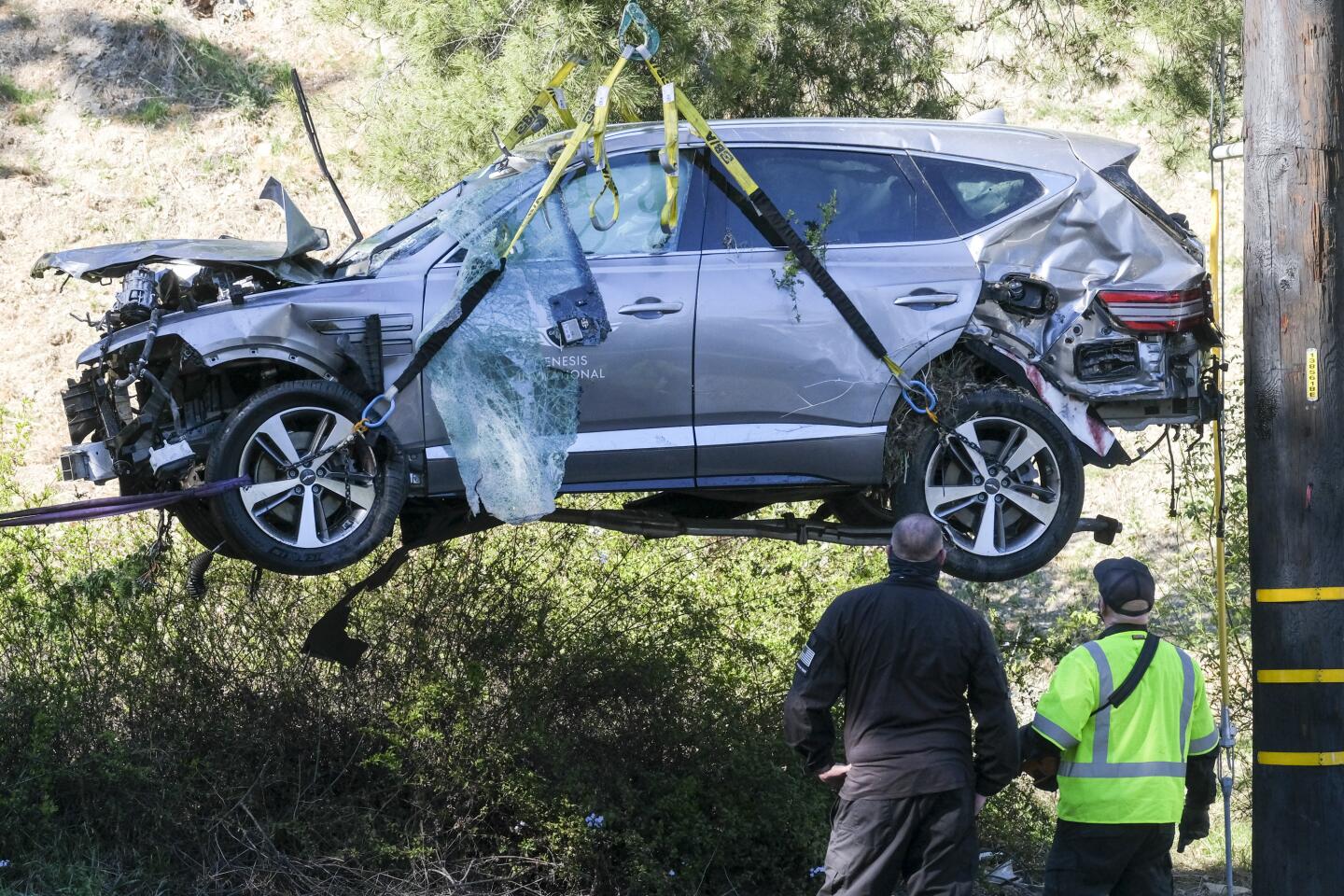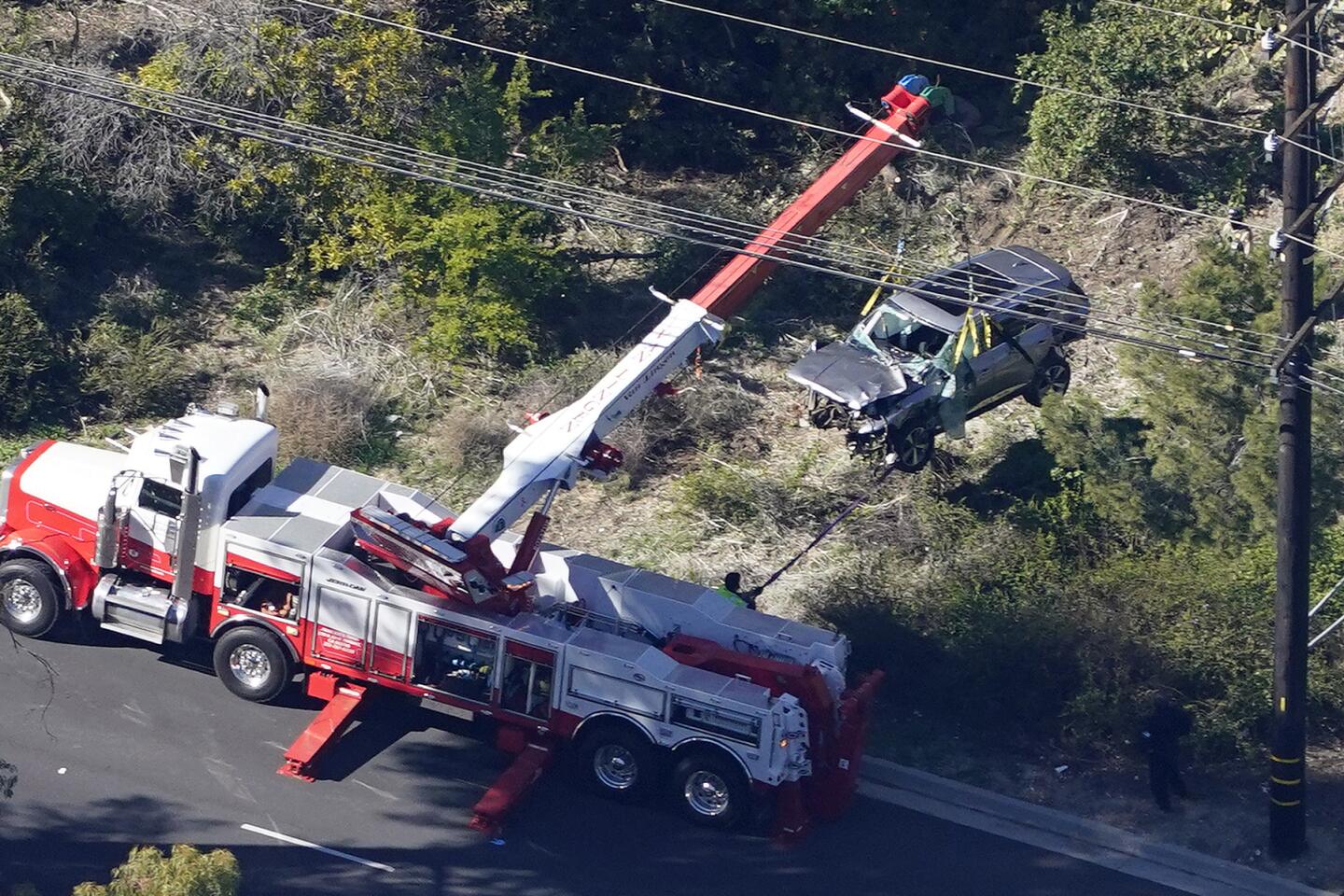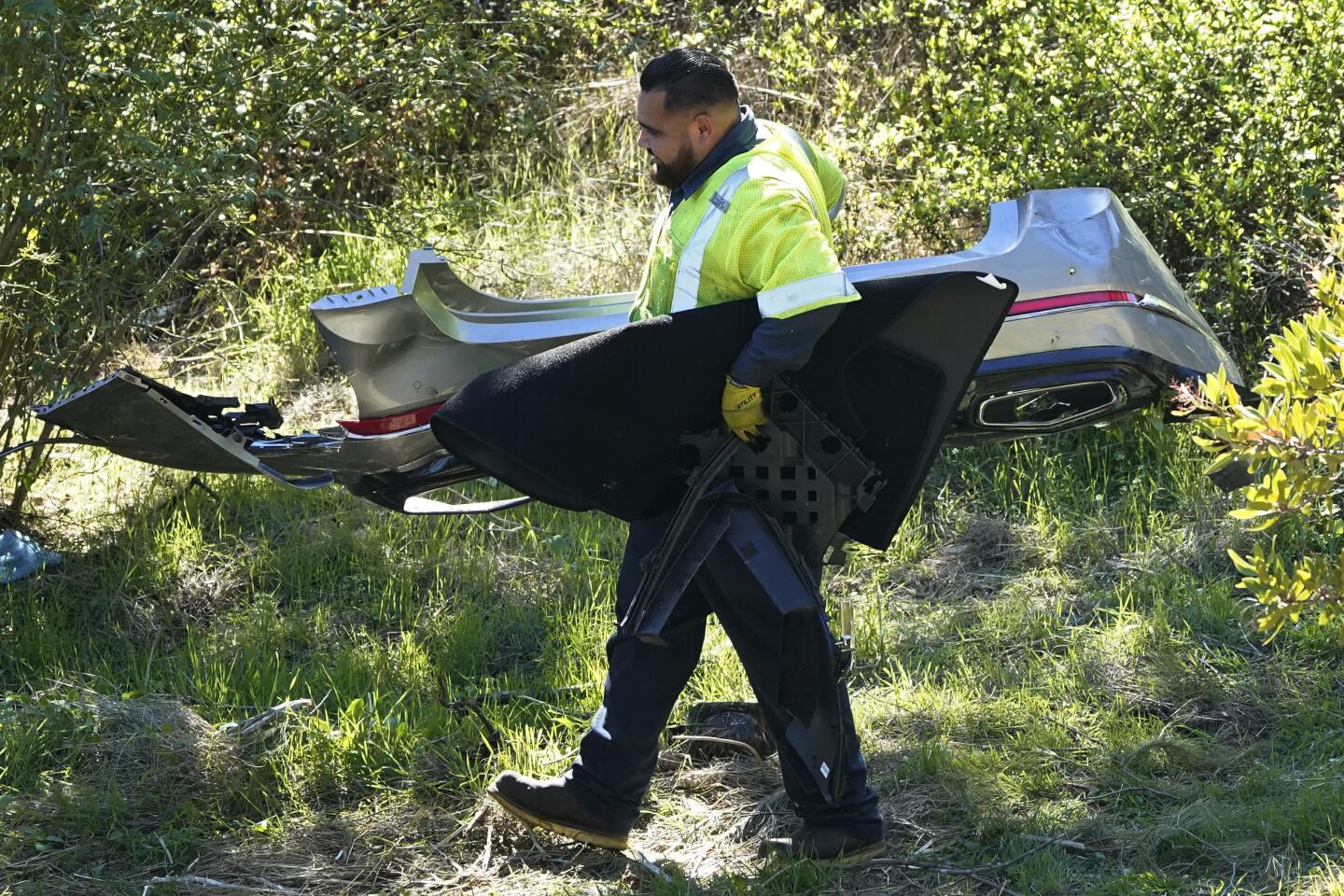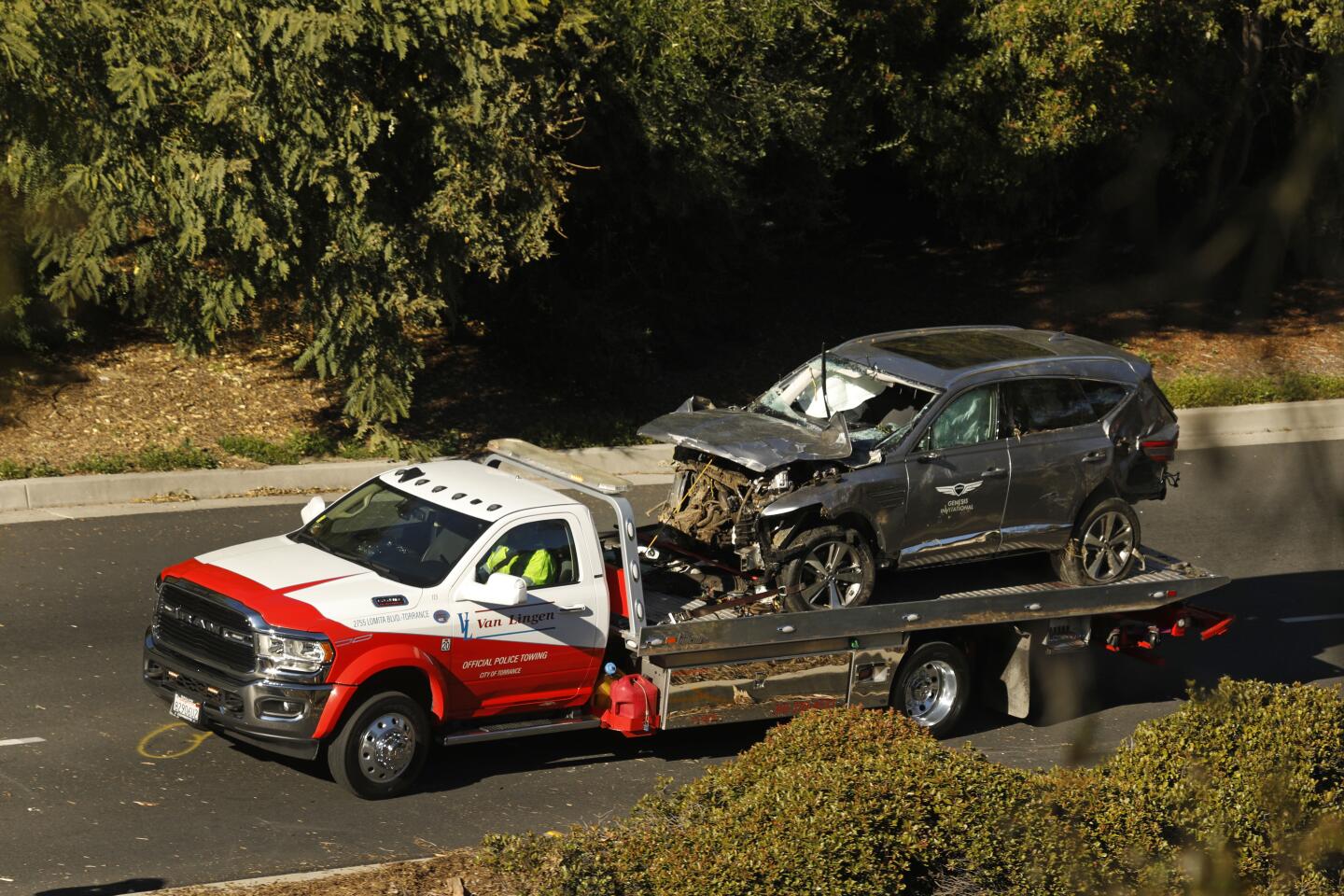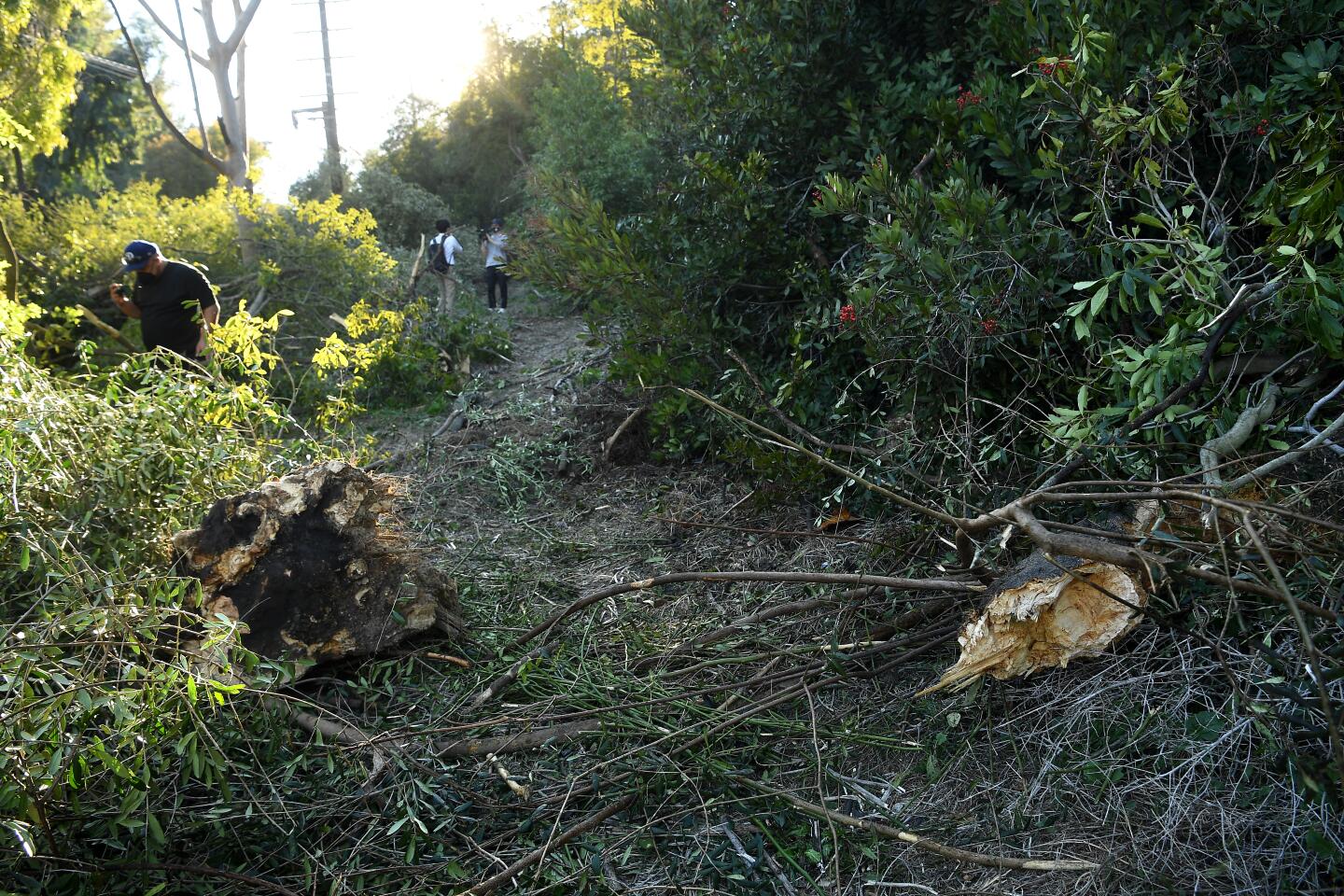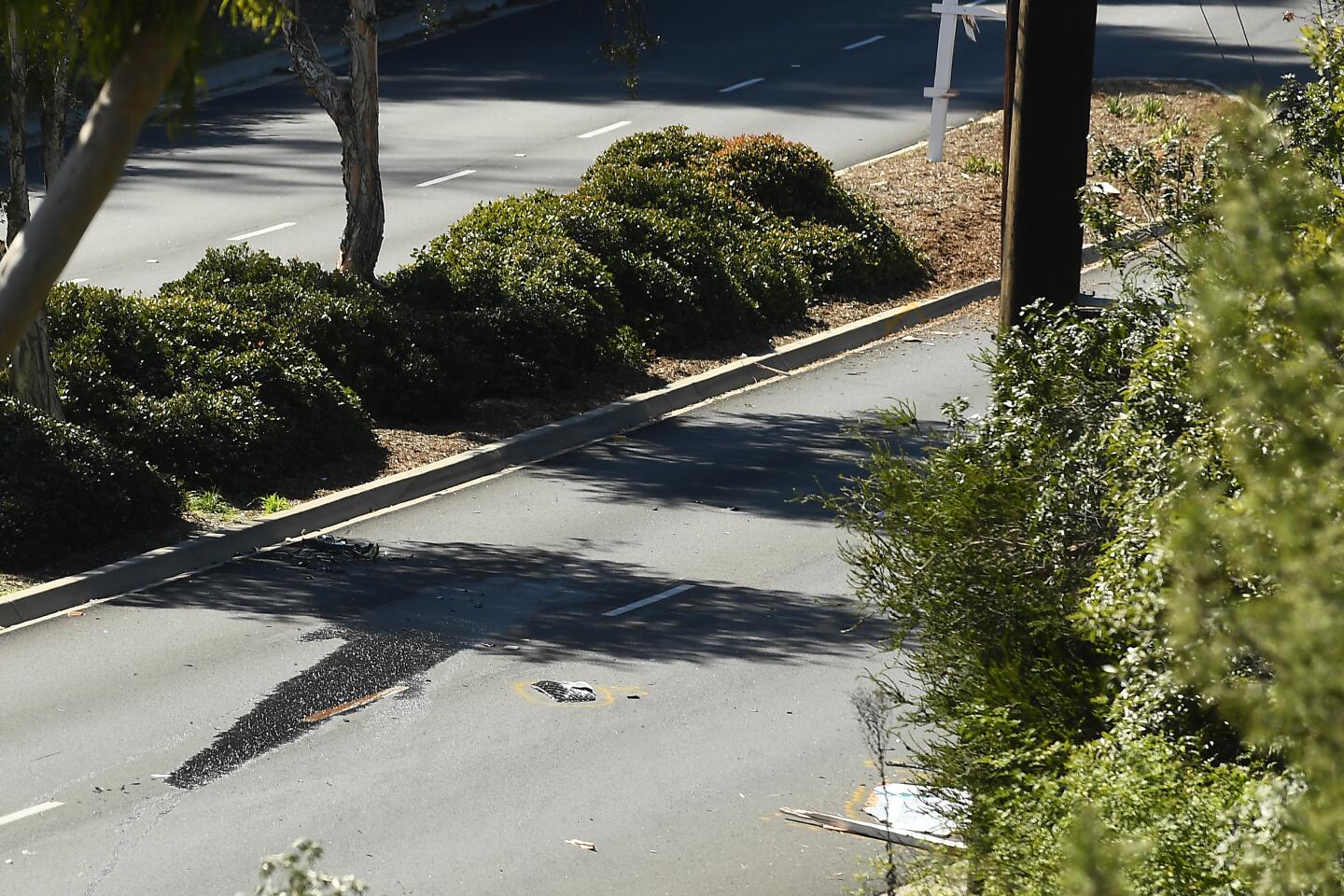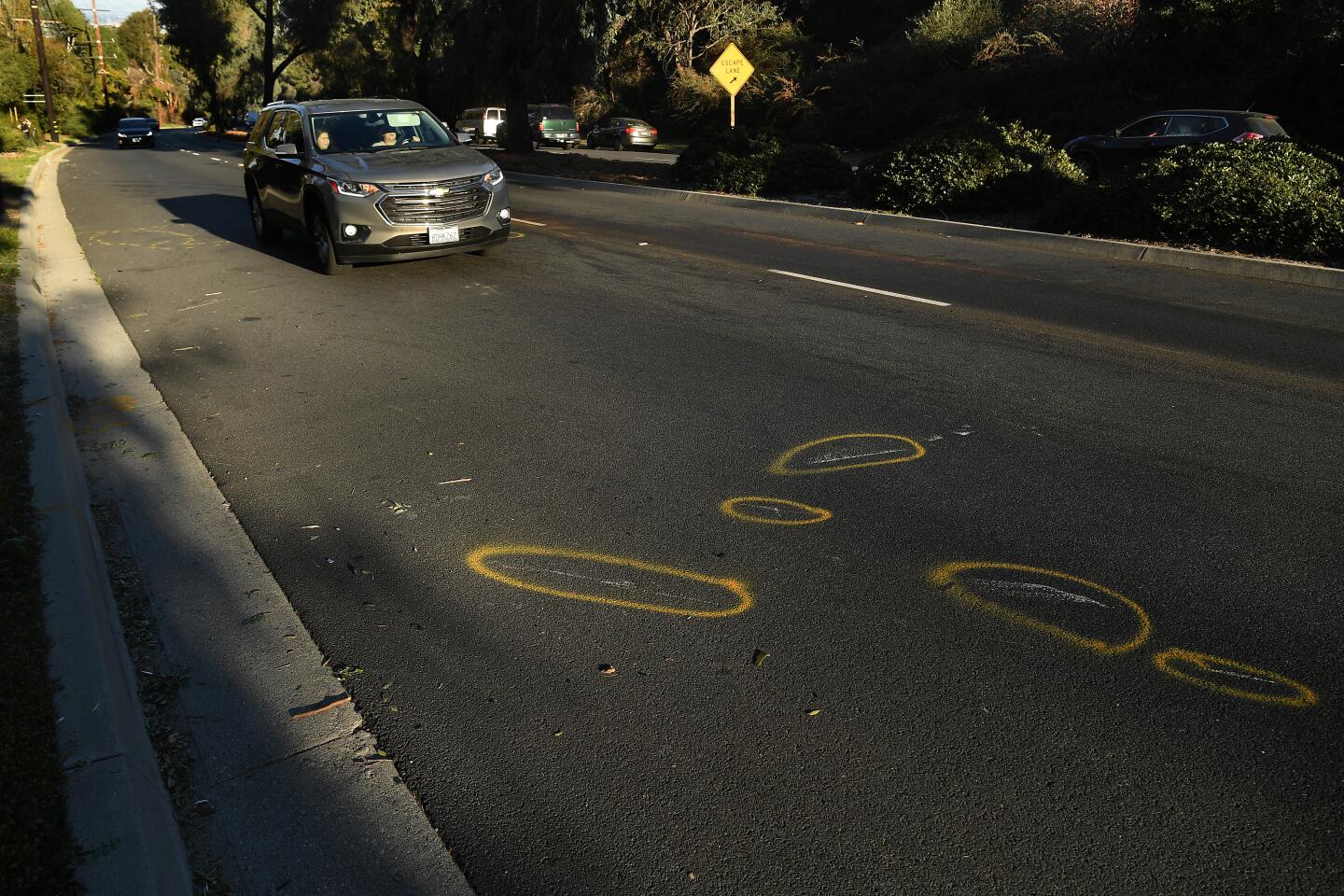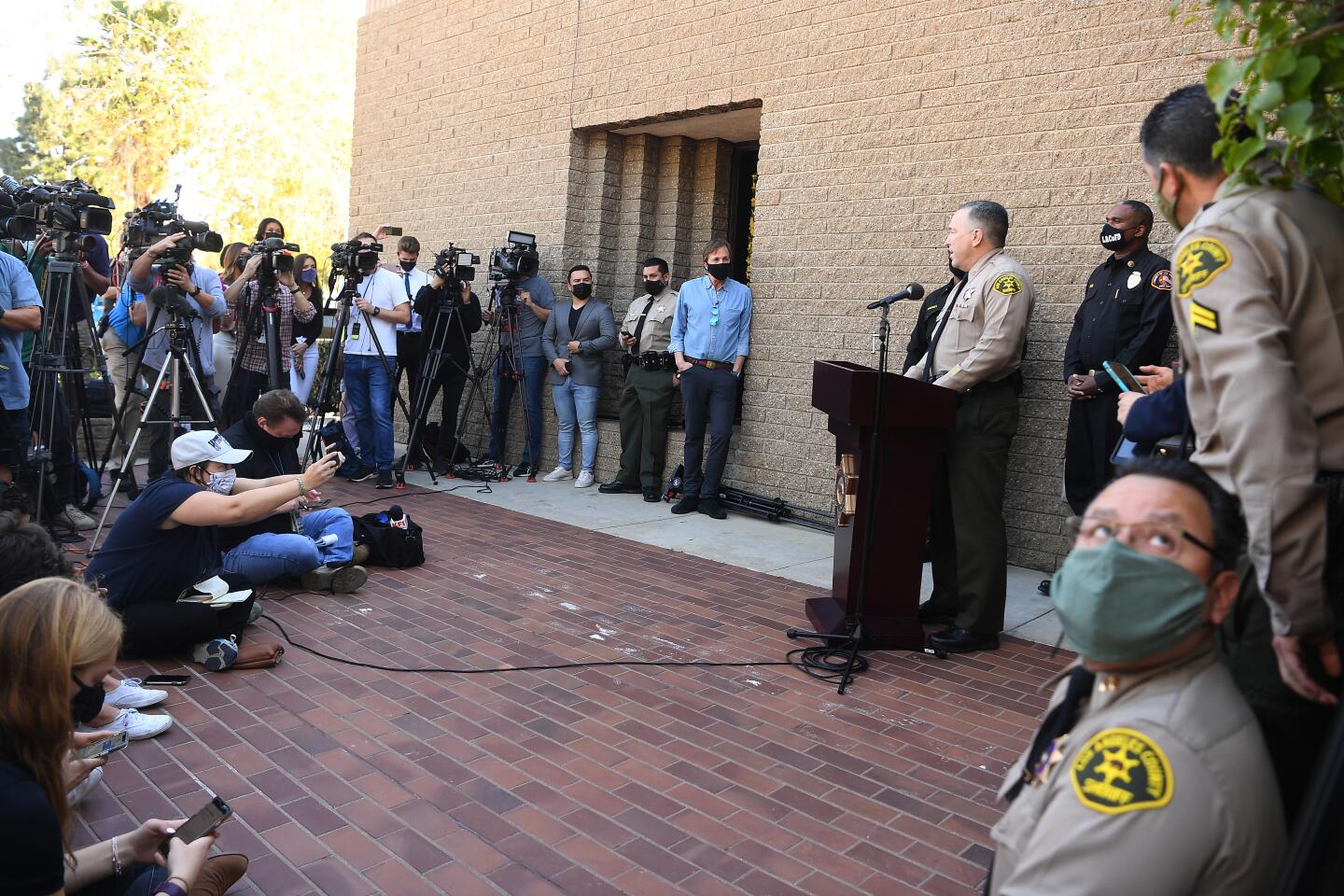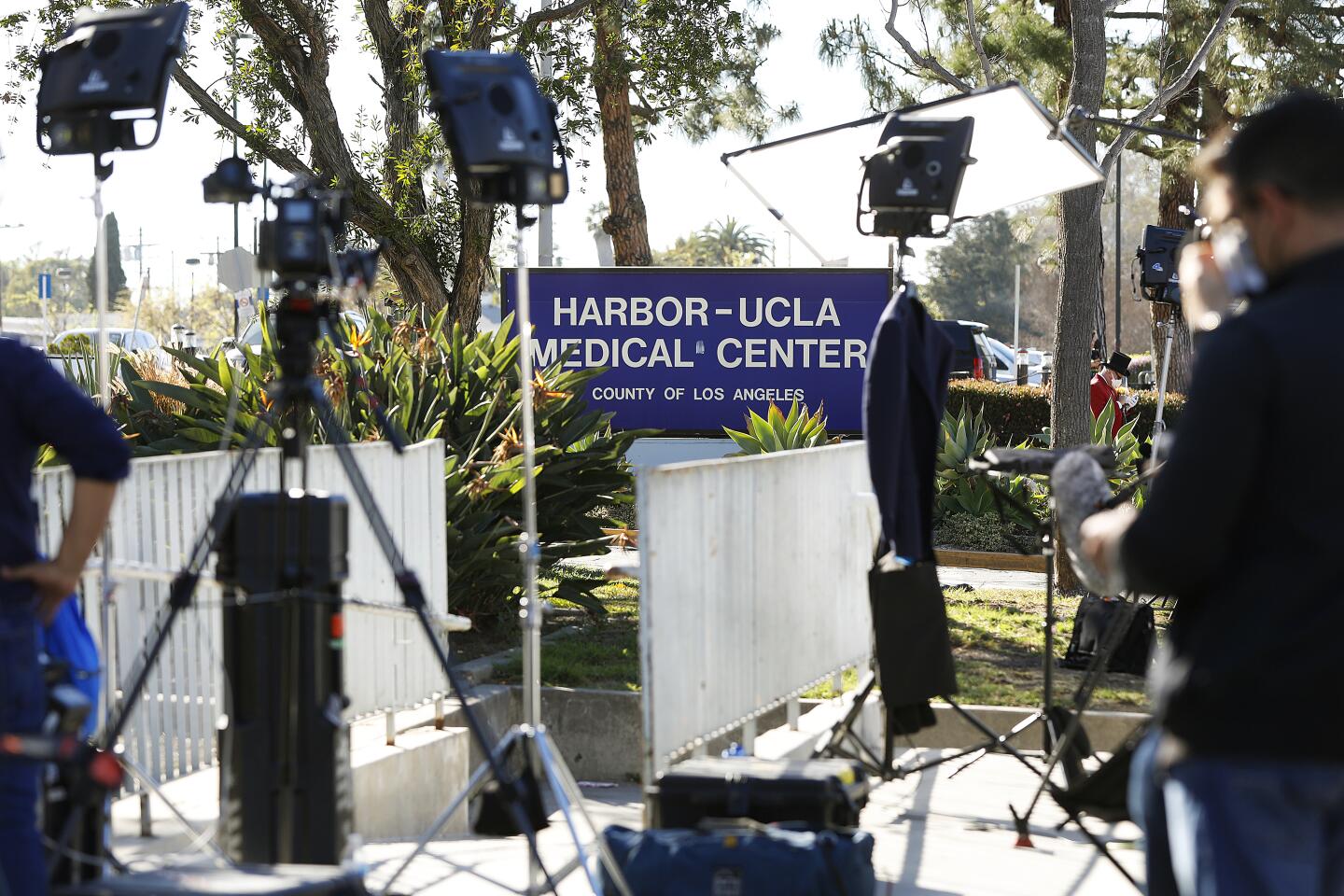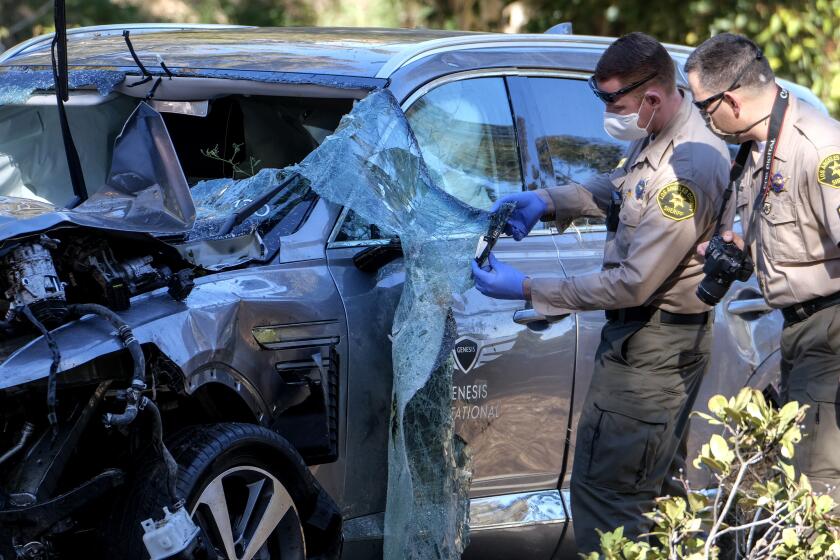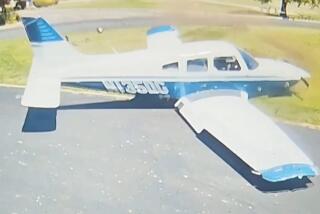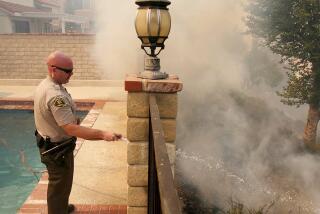Tiger Woods rollover crash was ‘purely an accident,’ no charges planned, sheriff says
- Share via
The rollover crash on a steep road on the Palos Verdes Peninsula that badly broke legendary golfer Tiger Woods’ leg and jeopardized his career was an accident, and no criminal charges will be filed against Woods, Los Angeles County Sheriff Alex Villanueva said Wednesday.
“This is purely an accident,” Villanueva said at a news conference.
The “black box” from Woods’ SUV will provide investigators with information on how fast he was driving when he lost control just after 7 a.m. Tuesday, Villanueva said.
Villanueva had previously said the vehicle was traveling at a “relatively greater speed than normal” down Hawthorne Boulevard near Blackhorse Road when it crossed the center divider and rolled over, coming to rest about 30 yards up a hillside.
“We are hoping it will be quick with this black box,” he said Wednesday. “The speed, it was maybe a factor in this accident.”
‘It could be a mixture of adrenaline, it could’ve been shock’ that kept Tiger Woods calm after crash, the first deputy on the scene tells ‘Today.’
Investigators did not yet know whether Woods was distracted when he crashed, but “we’ll find out,” Villanueva said, adding that Woods’ cellphone records could be relevant.
Woods seemed lucid and did not smell like he had been drinking, so the deputy who arrived first at the scene had no reason to test him for drugs or alcohol, Villanueva said.
“There was no evidence of any impairment whatsoever,” Villanueva said.
The deputy, Carlos Gonzalez, quickly recognized Woods, but the golfer did not receive special treatment because of his celebrity, Villanueva said.
Nothing in the sequence of events points to reckless driving or any other crime, Villanueva said. Even if the cause was distracted driving, that would be “an infraction,” not a crime, he said.
Hawthorne Boulevard, with a speed limit of 45 miles per hour, is one of the main routes out of the Palos Verdes Peninsula. The combination of the steep grade, curves and wide lanes often leads to accidents. Signs warn trucks to use lower gears, and an emergency turnout occupies the right shoulder toward the bottom of the hill.
Villanueva noted that it is easy for drivers to go faster than the speed limit if they are not careful.
“In this stretch of road, going downhill on a curve, even if you’re not accelerating, just by gravity alone, you’re going to start going faster,” he said.
Since last January, there have been 13 accidents, including four with injuries, on the stretch of road where Woods crashed, Villanueva said.
“You can have driver’s inattention, you can have any distraction like that, you can have speed involved,” he said.
There is a new push to examine safety issues on Hawthorne Boulevard on the Palos Verdes Peninsula after Tiger Woods was seriously hurt in a rollover crash.
His team will be speaking with Rancho Palos Verdes and Rolling Hills Estates officials on how to improve safety on Hawthorne Boulevard, he told The Times after the news conference. The crash occurred at the border of the two cities.
On Wednesday, L.A. County Supervisor Janice Hahn said she has directed the county Department of Public Works to conduct a safety review of the stretch of road where the accident occurred, which lies in her district.
Woods, 45, underwent “a long surgical procedure” on his right leg, foot and ankle after the accident.
Doctors inserted a rod into his leg and placed screws in his foot and ankle, according to a statement posted to Twitter, which described Woods as “awake, responsive and recovering.”
Dr. Anish Mahajan, chief medical officer at Harbor-UCLA Medical Center, where Woods was treated, described “comminuted open fractures affecting both the upper and lower portions of the tibia and fibula bones,” adding that trauma to the muscle and soft tissue of Woods’ leg required “surgical release of the covering of the muscles to relieve pressure due to swelling.”
It is unclear how long Woods will remain in the hospital or how his condition may affect his golf comeback.
Woods was the sole occupant of the 2021 Genesis GV80 SUV, which sustained major damage.
The sheriff said that there were no skid marks or signs of braking and that the golfer’s vehicle hit the center divider and a curb and sheared off a tree in the rollover crash.
Preventing infection is an issue in the recovery of Tiger Woods since bone broke skin during his car accident.
A wooden “Welcome to Rolling Hills Estates” sign on the median was obliterated. There was a license plate and fluid on the southbound side of the road, and Woods’ SUV narrowly missed a telephone pole as it careened up the hillside.
Villanueva praised Gonzalez for waiting for Los Angeles County fire personnel to extricate Woods from the vehicle, since he seemed stable and was not in immediate danger.
The PGA star was in Los Angeles as the host of the Genesis Invitational at Riviera Country Club, a golf tournament that concluded Sunday. He did not play in the event, as he was recovering from his fifth back surgery, but told CBS announcer Jim Nantz in an interview during the final round that he hoped to play in the Masters in April.
“God, I hope so. I’ve got to get there first,” Woods said in the interview. “A lot of it is based on my surgeons and doctors and therapist and making sure I do it correctly. This is the only back I’ve got; I don’t have much more wiggle room left.”
Woods stayed in Los Angeles County after the tournament to participate in a two-day content shoot with Golf Digest/GolfTV. Although he did not hit balls or play any holes Monday, a smiling Woods was with retired NBA star Dwyane Wade and comedian David Spade — both of whom documented the outing on social media — at the Rolling Hills Country Club. Part of the shoot involved Woods giving lessons on the course to celebrities.
A source familiar with the investigation said Woods was staying at the Terranea Resort in Rancho Palos Verdes and had left there early Tuesday to head back to the country club, about 20 minutes away, for filming. Golf Digest confirmed that Woods was on his way there for an additional photo and video shoot when the crash occurred.
Tiger Woods’ catastrophic crash in Los Angeles has cast a spotlight on the low-budget documentary series that featured golf’s biggest star.
Investigators were trying to determine whether any other vehicles were on the road at the time and might have played a role in the crash. Villanueva said that fortunately, no one was traveling in the opposite lanes when Woods’ car skipped the median.
Dr. Gregory Tennant, an orthopedic surgeon at Kaiser Permanente Medical Center in Fontana, said in an interview Wednesday morning that fractures are categorized as “open” or “closed” depending on whether the bone has come through the skin.
In Woods’ case, Tennant said, a “comminuted open fracture” would imply that the bone did penetrate the skin and broke into multiple pieces that might include bone shards.
Picture “smashing like an egg,” he said, “as opposed to the breaking of a stick.”
Tennant, who did not treat Woods but has extensive experience with similar injuries, said rods, screws and pins like those used to stabilize the golfer’s injuries are often intended to remain in the body for life.
The “surgical release of muscle coverings” to relieve swelling is a typical treatment for “impending compartment syndrome,” Tennant said, which can occur in “high-energy” injuries such as those caused by car accidents.
The soft-tissue layer that wraps around different leg muscles can act like a tourniquet or “very strong Saran Wrap” and cut off blood flow, potentially causing damage to muscles and nerves and even requiring amputation, he said.
Tiger Woods’ accident sends the golf star to the hospital after he was extricated from a rollover wreck near Rancho Palos Verdes.
One or two incisions along the length of the leg can allow the muscle to expand and release the pressure.
Woods’ road to recovery is likely to be long, Tennant said. Treatment in the initial days would typically involve antibiotics while keeping an eye out for infection and blood flow issues.
In the next six to nine months, the focus probably will be on bone and wound healing, followed by physical therapy and rehabilitation.
“My expectation would be that I wouldn’t anticipate him up and walking around for awhile,” Tennant said.
Although the majority of the injuries described by Woods’ doctors were in his lower extremities, the accident could have affected his often-injured back.
“Trauma is never truly an isolated event,” Tennant said. “It is not uncommon to identify injuries — even significant injuries — days later, as the initial high-energy injuries are dealt with.”
Woods is in good hands at Harbor-UCLA, which routinely handles these kinds of injuries, Tennant said. And his track record as a dedicated, elite athlete could help in his recovery.
“Tiger Woods has been a winner his whole life, and one thing I’ve learned is that you don’t bet against winners,” Tennant said. “You don’t bet against Michael Jordan. You don’t bet against Tiger Woods.”
As Tiger Woods recovers from injuries suffered in a car crash, here’s a look back at injuries he’s overcome over the course of his golf career.
More to Read
Sign up for Essential California
The most important California stories and recommendations in your inbox every morning.
You may occasionally receive promotional content from the Los Angeles Times.
